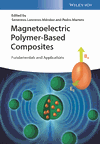Open Questions, Challenges, and Perspectives
Summary
This conclusion presents some closing thoughts on the key concepts discussed in the preceding chapters of this book. The book summarizes the pronounced evolution of polymer-based magnetoelectric (ME) materials in the past years by presenting the main materials, physicochemical insights, theoretical frameworks, experimental findings, and device applications. It shows that research and development in ME materials and particularly polymer-based ME materials is one of the areas that receive intense research interest and have large potential within the field of smart materials. Compared to ceramic or single-phase MEs, polymer-based ME materials are easier to integrate on a chip and their interfaces can be controlled or designed for enhanced ME coupling or introducing new functionalities - features that can be exploited for many exciting device technologies. The book concludes with a subjective perspective rather with irrefutable conclusions.



